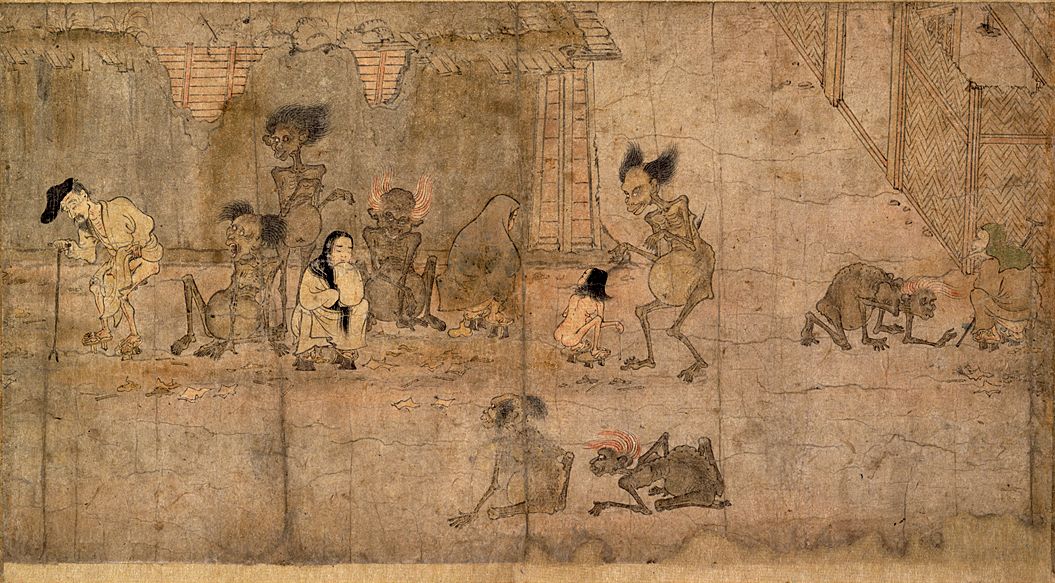|
Segaki
The is a ritual of Japanese Buddhism, traditionally performed to stop the suffering of the such restless ghosts/monsters as '' gaki'', ''jikininki'' and the ''muenbotoke'' (the dead who have no living relatives), ghosts tormented by insatiable hunger. Alternatively, the ritual forces them to return to their portion of hell or keeps the spirits of the dead from falling into the realm of the gaki. The segaki may be performed at any time, but traditionally performed as part of the yearly '' Urabon'e'' ( sa, उल्लम्बन ''Ullambana'') services in July to remember the dead and the segaki ritual for offering alms to specifically hungry gaki or muenbotoke, not for spirits of one's ancestor. The ritual is held at Buddhist temples and there is a custom to place segaki-dana (rack for gaki) or gaki-dana (shelf for gaki) at home, present offerings (traditionally rice and water) for hungry ghosts who are wandering in this world as muenbotoke during Urabon'e or O-bon. The segaki beg ... [...More Info...] [...Related Items...] OR: [Wikipedia] [Google] [Baidu] |
Gaki-do
Preta ( sa, प्रेत, bo, ཡི་དྭགས་ ''yi dags''), also known as hungry ghost, is the Sanskrit name for a type of supernatural being described in Hinduism, Buddhism, Taoism, and Chinese folk religion as undergoing suffering greater than that of humans, particularly an extreme level of hunger and thirst. They have their origins in Indian religions and have been adopted into East Asian religions via the spread of Buddhism. Preta is often translated into English as "hungry ghost" from the Chinese and East Asian adaptations. In early sources such as the ''Petavatthu'', they are much more varied. The descriptions below apply mainly in this narrower context. The development of the concept of the preta started with just thinking that it was the soul and ghost of a person once they died, but later the concept developed into a transient state between death and obtaining karmic reincarnation in accordance with the person's fate. In order to pass into the cycle of kar ... [...More Info...] [...Related Items...] OR: [Wikipedia] [Google] [Baidu] |
Preta
Preta ( sa, प्रेत, bo, ཡི་དྭགས་ ''yi dags''), also known as hungry ghost, is the Sanskrit name for a type of supernatural being described in Hinduism, Buddhism, Taoism, and Chinese folk religion as undergoing suffering greater than that of humans, particularly an extreme level of hunger and thirst. They have their origins in Indian religions and have been adopted into East Asian religions via the spread of Buddhism. Preta is often translated into English as "hungry ghost" from the Chinese and East Asian adaptations. In early sources such as the ''Petavatthu'', they are much more varied. The descriptions below apply mainly in this narrower context. The development of the concept of the preta started with just thinking that it was the soul and ghost of a person once they died, but later the concept developed into a transient state between death and obtaining karmic reincarnation in accordance with the person's fate. In order to pass into the cycle of ka ... [...More Info...] [...Related Items...] OR: [Wikipedia] [Google] [Baidu] |
Ritual
A ritual is a sequence of activities involving gestures, words, actions, or objects, performed according to a set sequence. Rituals may be prescribed by the traditions of a community, including a religious community. Rituals are characterized, but not defined, by formalism, traditionalism, invariance, rule-governance, sacral symbolism, and performance. Rituals are a feature of all known human societies. They include not only the worship rites and sacraments of organized religions and cults, but also rites of passage, atonement and ritual purification, purification rites, oaths of allegiance, dedication ceremonies, coronations and presidential inaugurations, marriages, funerals and more. Even common actions like handshake, hand-shaking and saying "hello" may be termed as ''rituals''. The field of ritual studies has seen a number of conflicting definitions of the term. One given by Kyriakidis is that a ritual is an outsider's or "Emic and etic, etic" category for a set activity (o ... [...More Info...] [...Related Items...] OR: [Wikipedia] [Google] [Baidu] |
Exorcism
Exorcism () is the religious or spiritual practice of evicting demons, jinns, or other malevolent spiritual entities from a person, or an area, that is believed to be possessed. Depending on the spiritual beliefs of the exorcist, this may be done by causing the entity to swear an oath, performing an elaborate ritual, or simply by commanding it to depart in the name of a higher power. The practice is ancient and part of the belief system of many cultures and religions. Buddhism The practice of reciting or listening to the Paritta began very early in the history of Buddhism. It is a Buddhist practice of reciting certain verses and scriptures from Pali Canon in order to ward off misfortune or danger. The belief in the effective spiritual power to heal, or protect, of the '' Sacca-kiriyā'', or asseveration of something quite true is an aspect of the work ascribed to the ''paritta''. Several scriptures in the Paritta like Metta Sutta, Dhajagga Sutta, or Ratana Sutta can be reci ... [...More Info...] [...Related Items...] OR: [Wikipedia] [Google] [Baidu] |
Obon
or just is fusion of the ancient Japanese belief in ancestral spirits and a Japanese Buddhist custom to honor the spirits of one's ancestors. This Buddhist–Confucian custom has evolved into a family reunion holiday during which people return to ancestral family places and visit and clean their ancestors' graves when the spirits of ancestors are supposed to revisit the household altars. It has been celebrated in Japan for more than 500 years and traditionally includes a dance, known as . The festival of Obon lasts for three days; however, its starting date varies within different regions of Japan. When the lunar calendar was changed to the Gregorian calendar at the beginning of the Meiji era, the localities in Japan responded differently, which resulted in three different times of Obon. (Bon in July) is based on the solar calendar and is celebrated around the 15th of July in eastern Japan ( Kantō region such as Tokyo, Yokohama and the Tōhoku region), coinciding with . ... [...More Info...] [...Related Items...] OR: [Wikipedia] [Google] [Baidu] |
Routledge
Routledge () is a British multinational publisher. It was founded in 1836 by George Routledge, and specialises in providing academic books, journals and online resources in the fields of the humanities, behavioural science, education, law, and social science. The company publishes approximately 1,800 journals and 5,000 new books each year and their backlist encompasses over 70,000 titles. Routledge is claimed to be the largest global academic publisher within humanities and social sciences. In 1998, Routledge became a subdivision and imprint of its former rival, Taylor & Francis Group (T&F), as a result of a £90-million acquisition deal from Cinven, a venture capital group which had purchased it two years previously for £25 million. Following the merger of Informa and T&F in 2004, Routledge became a publishing unit and major imprint within the Informa "academic publishing" division. Routledge is headquartered in the main T&F office in Milton Park, Abingdon, Oxfordshire and ... [...More Info...] [...Related Items...] OR: [Wikipedia] [Google] [Baidu] |
Sri Lanka
Sri Lanka (, ; si, ශ්රී ලංකා, Śrī Laṅkā, translit-std=ISO (); ta, இலங்கை, Ilaṅkai, translit-std=ISO ()), formerly known as Ceylon and officially the Democratic Socialist Republic of Sri Lanka, is an island country in South Asia. It lies in the Indian Ocean, southwest of the Bay of Bengal, and southeast of the Arabian Sea; it is separated from the Indian subcontinent by the Gulf of Mannar and the Palk Strait. Sri Lanka shares a maritime border with India and Maldives. Sri Jayawardenepura Kotte is its legislative capital, and Colombo is its largest city and financial centre. Sri Lanka has a population of around 22 million (2020) and is a multinational state, home to diverse cultures, languages, and ethnicities. The Sinhalese are the majority of the nation's population. The Tamils, who are a large minority group, have also played an influential role in the island's history. Other long established groups include the Moors, the Burghers ... [...More Info...] [...Related Items...] OR: [Wikipedia] [Google] [Baidu] |
China
China, officially the People's Republic of China (PRC), is a country in East Asia. It is the world's most populous country, with a population exceeding 1.4 billion, slightly ahead of India. China spans the equivalent of five time zones and borders fourteen countries by land, the most of any country in the world, tied with Russia. Covering an area of approximately , it is the world's third largest country by total land area. The country consists of 22 provinces, five autonomous regions, four municipalities, and two Special Administrative Regions (Hong Kong and Macau). The national capital is Beijing, and the most populous city and financial center is Shanghai. Modern Chinese trace their origins to a cradle of civilization in the fertile basin of the Yellow River in the North China Plain. The semi-legendary Xia dynasty in the 21st century BCE and the well-attested Shang and Zhou dynasties developed a bureaucratic political system to serve hereditary monarchies, or dyna ... [...More Info...] [...Related Items...] OR: [Wikipedia] [Google] [Baidu] |
Lotus Sutra
The ''Lotus Sūtra'' ( zh, 妙法蓮華經; sa, सद्धर्मपुण्डरीकसूत्रम्, translit=Saddharma Puṇḍarīka Sūtram, lit=Sūtra on the White Lotus of the True Dharma, italic=) is one of the most influential and venerated Buddhist Mahāyāna sūtras. It is the main scripture on which the Tiantai, Tendai, Cheontae, and Nichiren schools of Buddhism were established. It is also influential for other East Asian Buddhist schools, such as Zen. According to the British Buddhologist Paul Williams, "For many Buddhists in East Asia since early times, the ''Lotus Sūtra'' contains the final teaching of Shakyamuni Buddha—complete and sufficient for salvation." The American Buddhologist Donald S. Lopez Jr. writes that the ''Lotus Sūtra'' "is arguably the most famous of all Buddhist texts," presenting "a radical re-vision of both the Buddhist path and of the person of the Buddha." Two central teachings of the ''Lotus Sūtra'' have been very i ... [...More Info...] [...Related Items...] OR: [Wikipedia] [Google] [Baidu] |
Moggallana
Maudgalyāyana ( pi, Moggallāna), also known as Mahāmaudgalyāyana or by his birth name Kolita, was one of the Buddha's closest disciples. Described as a contemporary of disciples such as Subhuti, Śāriputra ('), and Mahākāśyapa ( pi, Mahākassapa), he is considered the second of the Buddha's two foremost male disciples, together with Śāriputra. Traditional accounts relate that Maudgalyāyana and Śāriputra become spiritual wanderers in their youth. After having searched for spiritual truth for a while, they come into contact with the Buddhist teaching through verses that have become widely known in the Buddhist world. Eventually they meet the Buddha himself and ordain as monks under him. Maudgalyāyana attains enlightenment shortly after that. Maudgalyayana and Śāriputra have a deep spiritual friendship. They are depicted in Buddhist art as the two disciples that accompany the Buddha, and they have complementing roles as teachers. As a teacher, Maudgalyayana is ... [...More Info...] [...Related Items...] OR: [Wikipedia] [Google] [Baidu] |
Sakyamuni
Siddhartha Gautama, most commonly referred to as the Buddha, was a wandering ascetic and religious teacher who lived in South Asia during the 6th or 5th century BCE and founded Buddhism. According to Buddhist tradition, he was born in Lumbini, in what is now Nepal, to royal parents of the Shakya clan, but renounced his home life to live as a wandering ascetic ( sa, śramaṇa). After leading a life of begging, asceticism, and meditation, he attained enlightenment at Bodh Gaya in what is now India. The Buddha thereafter wandered through the lower Indo-Gangetic Plain, teaching and building a monastic order. He taught a Middle Way between sensual indulgence and severe asceticism, leading to Nirvana, that is, freedom from ignorance, craving, rebirth, and suffering. His teachings are summarized in the Noble Eightfold Path, a training of the mind that includes meditation and instruction in Buddhist ethics such as right effort, mindfulness, and ''jhana''. He died in Kush ... [...More Info...] [...Related Items...] OR: [Wikipedia] [Google] [Baidu] |








.jpg)